Laser Joining of Continuous Carbon Fiber-Reinforced PEEK and Titanium Alloy with High Strength
Abstract
1. Introduction
2. Materials and Methods
2.1. Materials
2.2. Laser Texturing Process
2.3. Laser Joining Process
2.4. Property Characterizations
3. Results and Discussion
4. Conclusions
Supplementary Materials
Author Contributions
Funding
Institutional Review Board Statement
Data Availability Statement
Acknowledgments
Conflicts of Interest
References
- Sajan, S.; Philip Selvaraj, D. A review on polymer matrix composite materials and their applications. Mater. Today Proc. 2021, 47, 5493–5498. [Google Scholar] [CrossRef]
- Nassiraei, H.; Rezadoost, P. Static capacity of tubular X-joints reinforced with fiber reinforced polymer subjected to compressive load. Eng. Struct. 2021, 236, 112041. [Google Scholar] [CrossRef]
- Nassiraei, H.; Rezadoost, P. SCFs in tubular X-joints retrofitted with FRP under out-of-plane bending moment. Mar. Struct. 2021, 79, 103010. [Google Scholar] [CrossRef]
- Nassiraei, H.; Rezadoost, P. Stress concentration factors in tubular T/Y-connections reinforced with FRP under in-plane bending load. Mar. Struct. 2021, 76, 102871. [Google Scholar] [CrossRef]
- Nassiraei, H.; Rezadoost, P. Parametric study and formula for SCFs of FRP-strengthened CHS T/Y-joints under out-of-plane bending load. Ocean Eng. 2021, 221, 108313. [Google Scholar] [CrossRef]
- Wang, S.; Xu, Y.; Wang, W.; Tian, Y.; Zhang, X.; Huang, H.; Zheng, D. Enhancing interfacial bonding in friction stir lap welding of light metal and carbon fiber reinforced polymer composite. J. Manuf. Process. 2022, 83, 729–741. [Google Scholar] [CrossRef]
- Li, M.; Xiong, X.; Ji, S.; Hu, W.; Yue, Y. Achieving high-quality metal to polymer-matrix composites joint via top-thermic solid-state lap joining. Compos. B—Eng. 2021, 219, 108941. [Google Scholar] [CrossRef]
- Wang, H.; Huang, B.; Li, J.; Li, N.; Liu, L. Welding and Riveting Hybrid Bonding of 6061 Al and Carbon Fiber Reinforced Composites. Polymers 2022, 14, 99. [Google Scholar] [CrossRef]
- Huang, Y.; Gao, X.; Zhang, Y.; Ma, B. Laser joining technology of polymer-metal hybrid structures—A review. J. Manuf. Process. 2022, 79, 934–961. [Google Scholar] [CrossRef]
- Wang, T.; Yasuda, K.; Nishikawa, H. Fabrication of micron-sized protrusions on metal surface for metal/polymer easy-disassembly joining by selective laser melting technology. Mater. Des. 2022, 220, 110873. [Google Scholar] [CrossRef]
- Tan, C.; Liu, Y.; Liu, F.; Su, J.; Zhang, Z.; Zhang, X.; Song, K.; Chen, B.; Song, X. Effect of laser power on laser joining of carbon fiber reinforced plastic to AZ31B Mg alloy. Opt. Laser Technol. 2022, 145, 107449. [Google Scholar] [CrossRef]
- Elahi, M.A.; Koch, M.; Bardon, J.; Addiego, F.; Plapper, P. Failure mechanism analysis based on laser-based surface treatments for aluminum-polyamide laser joining. J. Mater. Process. Technol. 2021, 298, 117318. [Google Scholar] [CrossRef]
- Rajak, D.K.; Wagh, P.H.; Kumar, A.; Sanjay, M.R.; Siengchin, S.; Khan, A.; Asiri, A.M.; Naresh, K.; Velmurugan, R.; Gupta, N.K. Impact of fiber reinforced polymer composites on structural joints of tubular sections: A review. Thin-Walled Struct. 2022, 180, 109967. [Google Scholar] [CrossRef]
- Kim, W.-S.; Yun, I.-H.; Lee, J.-J.; Jung, H.-T. Evaluation of mechanical interlock effect on adhesion strength of polymer-metal interfaces using micro-patterned surface topography. Int. J. Adhes. Adhes. 2010, 30, 408–417. [Google Scholar] [CrossRef]
- Xie, Y.; Zhang, J.; Zhou, T. Large-area mechanical interlocking via nanopores: Ultra-high-strength direct bonding of polymer and metal materials. Appl. Surf. Sci. 2019, 492, 558–570. [Google Scholar] [CrossRef]
- Bula, K.; Korzeniewski, B. Polyamide 6-Aluminum Assembly Enhanced by Laser Microstructuring. Polymers 2022, 14, 288. [Google Scholar] [CrossRef] [PubMed]
- Jiao, J.; Jia, S.; Xu, Z.; Ye, Y.; Sheng, L.; Zhang, W. Laser direct joining of CFRTP and aluminium alloy with a hybrid surface pre-treating method. Compos. B—Eng. 2019, 173, 106911. [Google Scholar] [CrossRef]
- Tan, X.; Zhang, J.; Shan, J.; Yang, S.; Ren, J. Characteristics and formation mechanism of porosities in CFRP during laser joining of CFRP and steel. Compos. B—Eng. 2015, 70, 35–43. [Google Scholar] [CrossRef]
- Wang, H.; Chen, Y.; Guo, Z.; Guan, Y. Porosity Elimination in Modified Direct Laser Joining of Ti6Al4V and Thermoplastics Composites. Appl. Sci. 2019, 9, 411. [Google Scholar] [CrossRef]
- Wang, H.; Feng, W.; Zhang, Z.; Guan, Y.; Zheng, H. Hybrid laser technique for joining of polymer and titanium alloy. J. Laser Appl. 2019, 31, 042017. [Google Scholar] [CrossRef]
- Wang, H.; Yan, P.; Guan, Y. Robust Heterojunctions of Metallic Alloy and Carbon Fiber-Reinforced Composite Induced by Laser Processing. Materials 2021, 14, 7469. [Google Scholar] [CrossRef] [PubMed]
- Lambiase, F.; Genna, S. Homogenization of temperature distribution at metal-polymer interface during Laser Direct Joining. Opt. Laser Technol. 2020, 128, 106226. [Google Scholar] [CrossRef]
- Schricker, K.; Samfaß, L.; Grätzel, M.; Ecke, G.; Bergmann, J.P. Bonding mechanisms in laser-assisted joining of metal-polymer composites. J. Adv. Join. Process. 2020, 1, 100008. [Google Scholar] [CrossRef]
- Rodríguez-Vidal, E.; Sanz, C.; Lambarri, J.; Quintana, I. Experimental investigation into metal micro-patterning by laser on polymer-metal hybrid joining. Opt. Laser Technol. 2018, 104, 73–82. [Google Scholar] [CrossRef]
- Bochkareva, S.A.; Panin, S.V. Effect of adhesion on mechanical properties of polyetheretherketone based laminated composites reinforced with carbon fibers. Procedia Struct. Integr. 2021, 32, 334–339. [Google Scholar] [CrossRef]
- Ma, X.; Wen, L.; Wang, S.; Xiao, J.; Li, W.; Hou, X. Inherent relationship between process parameters, crystallization and mechanical properties of continuous carbon fiber reinforced peek composites. Def. Technol. 2022, in press. [Google Scholar] [CrossRef]
- Tan, C.; Su, J.; Zhu, B.; Li, X.; Wu, L.; Chen, B.; Song, X.; Feng, J. Effect of scanning speed on laser joining of carbon fiber reinforced PEEK to titanium alloy. Opt. Laser Technol. 2020, 129, 106273. [Google Scholar] [CrossRef]
- Song, Y.; Wang, H.; Wang, Q.; Ma, C.; Guan, Y. Research and Application of Laser Fine Surface Processing Technology: Cleaning and Polishing. Aeronaut. Manuf. Technol. 2018, 61, 78–86. [Google Scholar]
- Zhao, S.; Kimura, F.; Kadoya, S.; Kajihara, Y. Experimental analysis on mechanical interlocking of metal–polymer direct joining. Precis. Eng. 2020, 61, 120–125. [Google Scholar] [CrossRef]
- Zou, Q.; Jiao, J.; Xu, J.; Sheng, L.; Zhang, Y.; Ouyang, W.; Xu, Z.; Zhang, M.; Xia, H.; Tian, R.; et al. Effects of laser hybrid interfacial pretreatment on enhancing the carbon fiber reinforced thermosetting composites and TC4 alloy heterogeneous joint. Mater. Today Commun. 2022, 30, 103142. [Google Scholar] [CrossRef]
- Shirasu, K.; Mizutani, M.; Takano, N.; Yoshinaga, H.; Oguri, T.; Ogawa, K.; Okabe, T.; Obayashi, S. Lap-shear strength and fracture behavior of CFRP/3D-printed titanium alloy adhesive joint prepared by hot-press-aided co-bonding. Int. J. Adhes. Adhes. 2022, 117, 103169. [Google Scholar] [CrossRef]

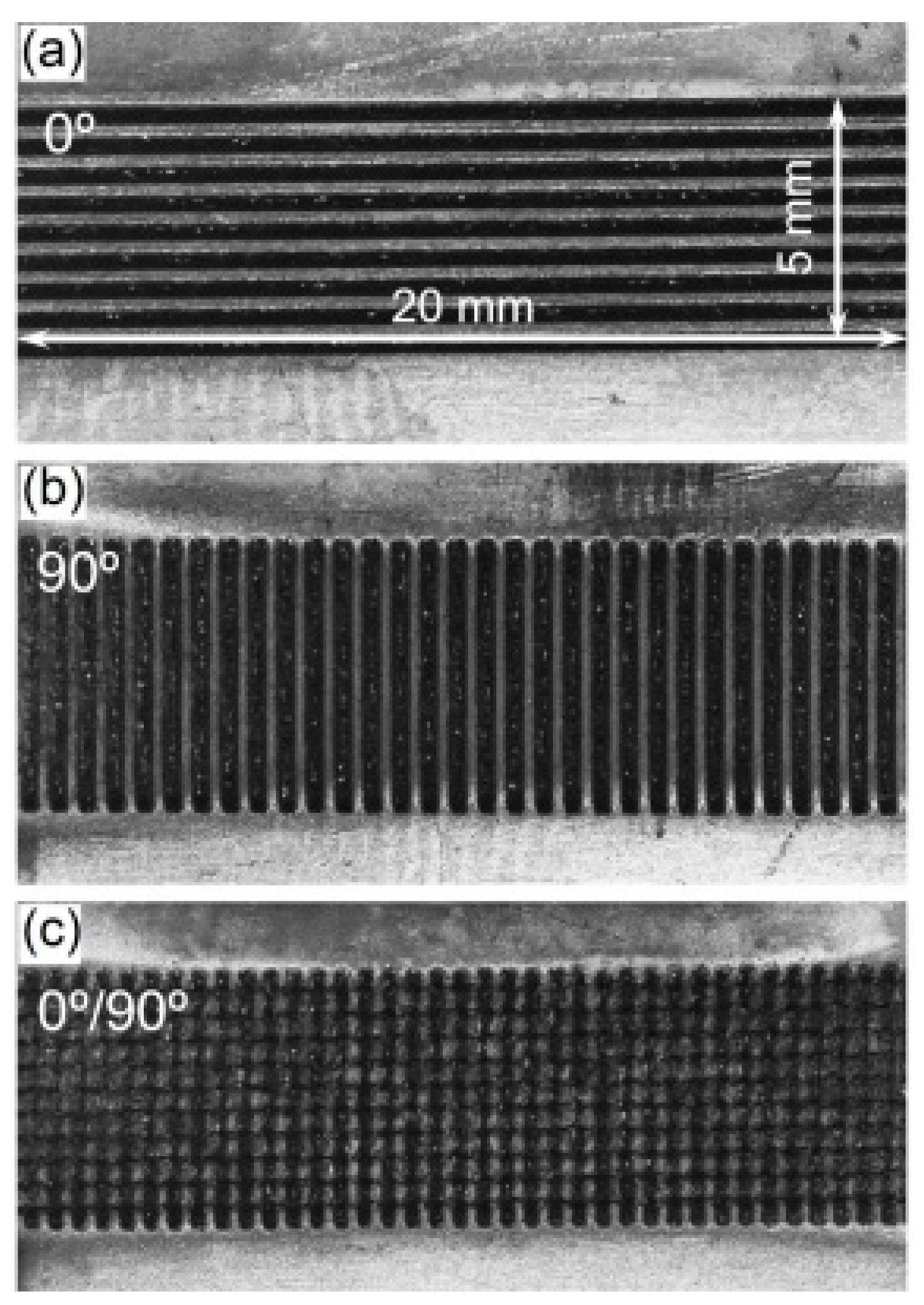
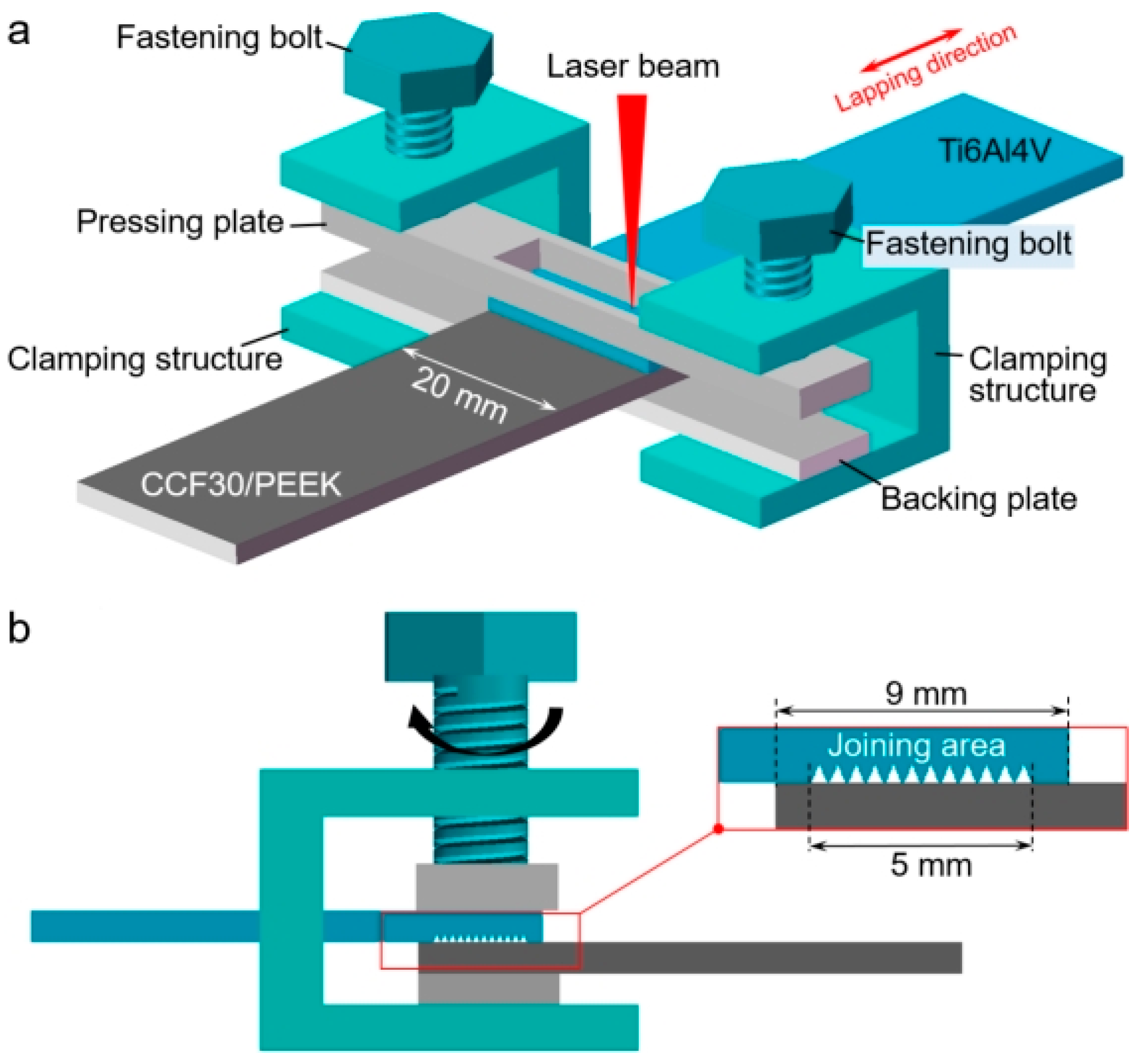
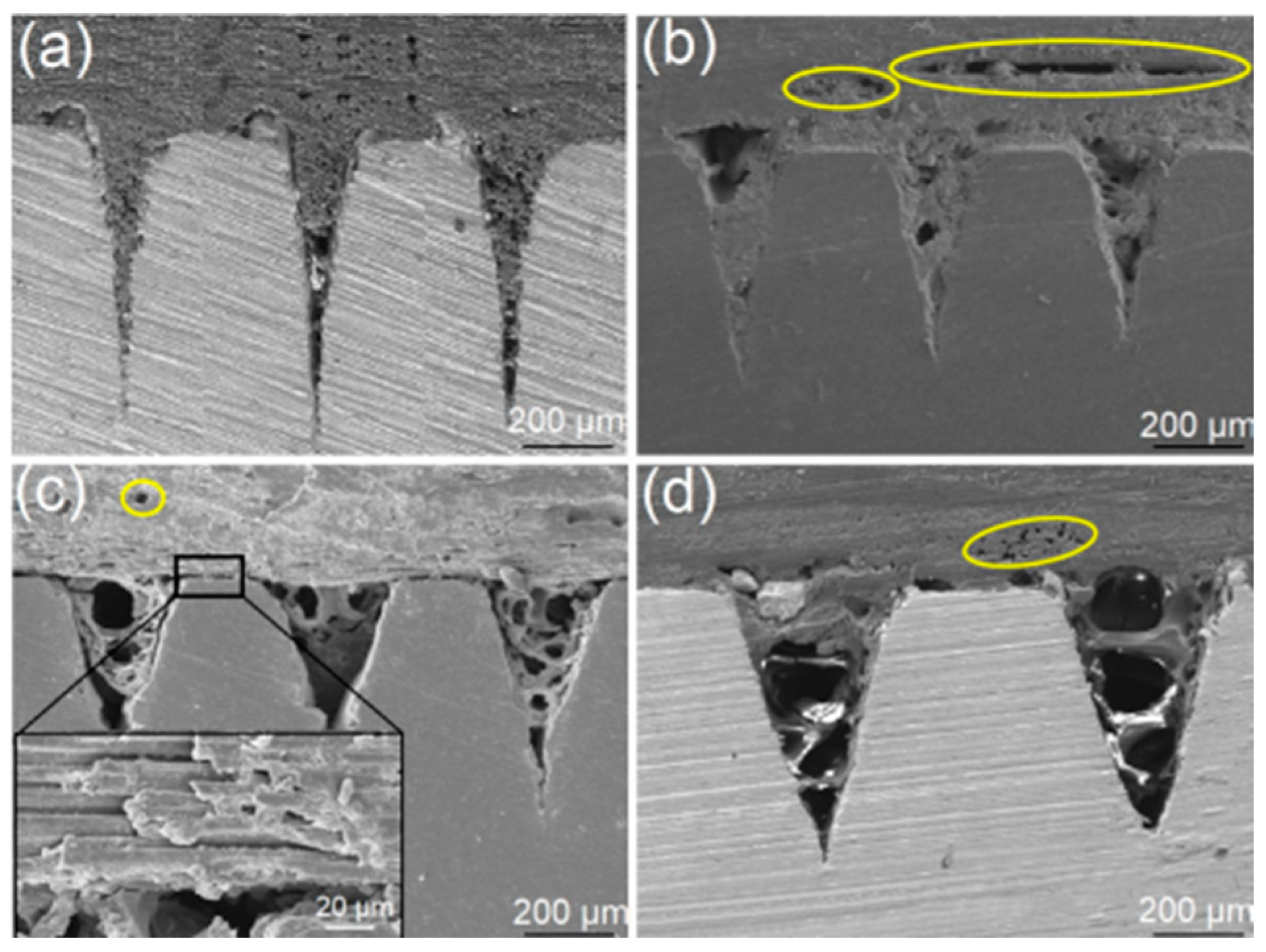


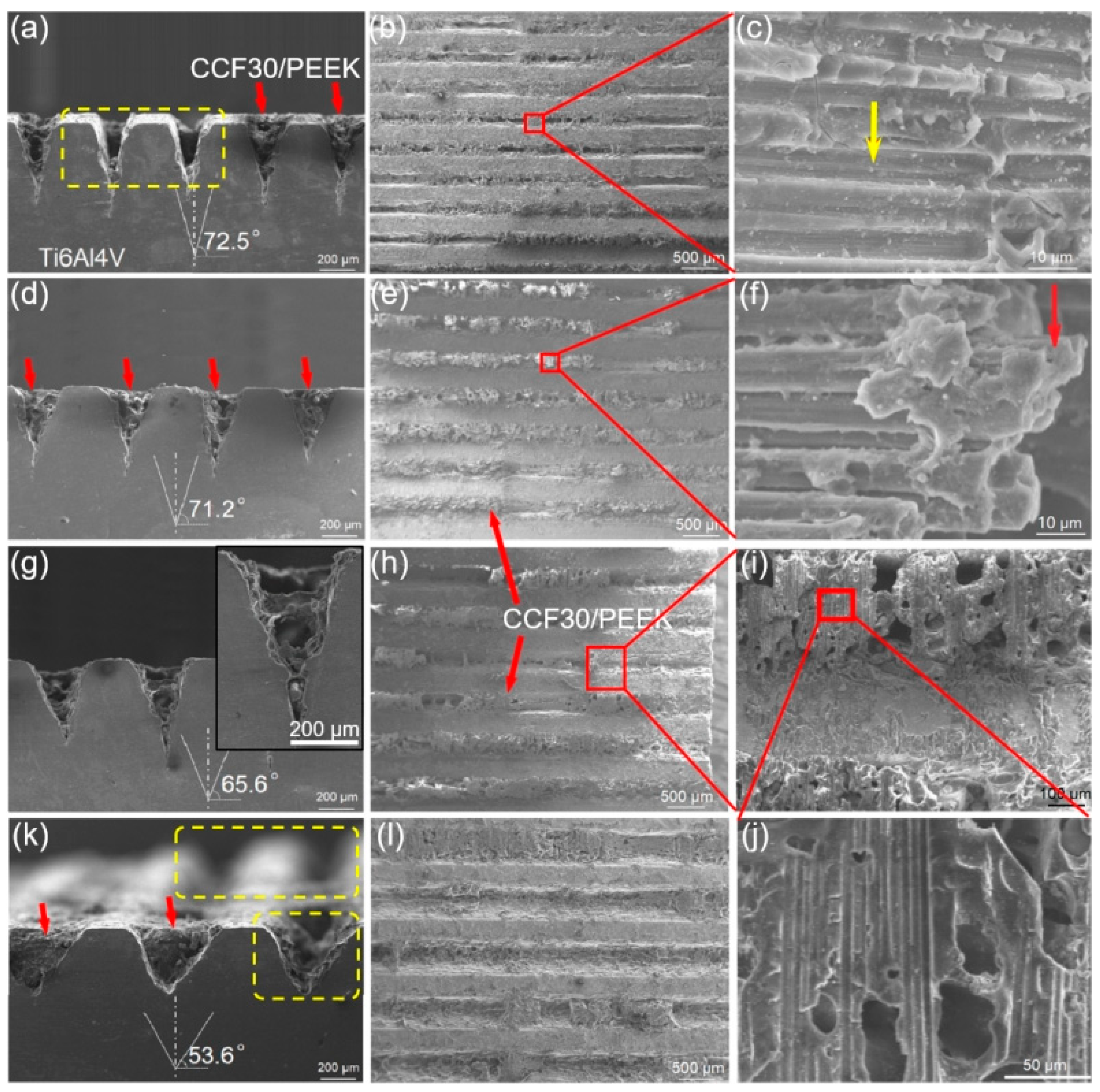
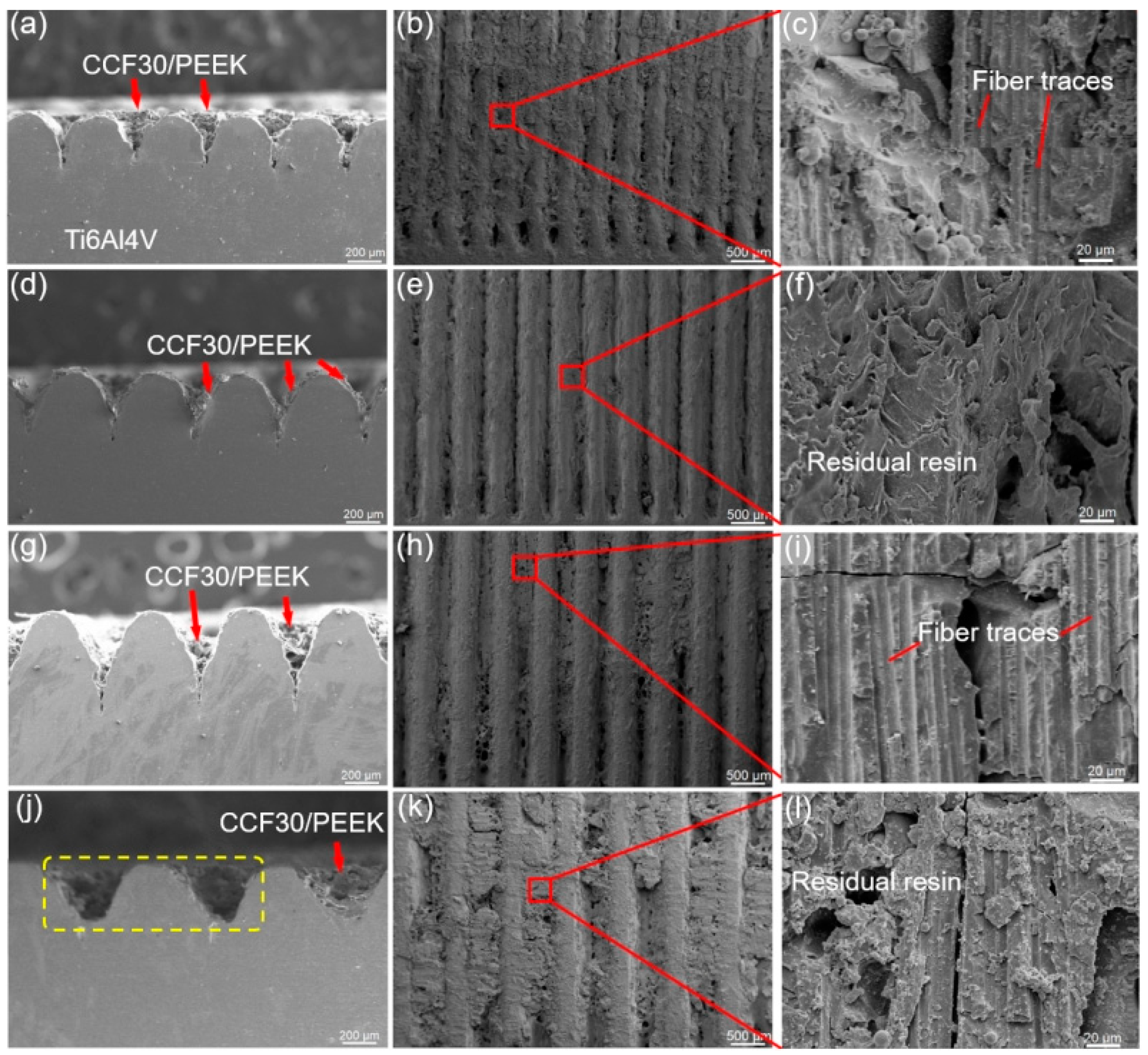

| Composition | C | Al | V | Ti |
|---|---|---|---|---|
| wt.% | ≤0.1 | 5.88 | 3.46 | Balance |
| Parameter | Value |
|---|---|
| Average output power, W | 70 |
| Pulse duration, ns | 50 |
| Pulse frequency, kHz | 55 |
| Travelling speed, mm/s | 300 |
| Wavelength, nm | 1030 |
| Characteristics | 0° Grating Pattern | 90° Grating Pattern | Grid Pattern | |||||||||
|---|---|---|---|---|---|---|---|---|---|---|---|---|
| #1 | #2 | #3 | #4 | #1 | #2 | #3 | #4 | #1 | #2 | #3 | #4 | |
| Width, μm | 225 ± 15 | 265 ± 10 | 335 ± 10 | 425 ± 15 | 225 ± 15 | 265 ± 10 | 335 ± 10 | 425 ± 15 | 225 ± 15 | 265 ± 10 | 335 ± 10 | 425 ± 15 |
| Distance, μm | 400 | 450 | 500 | 700 | 400 | 450 | 500 | 700 | 400 | 450 | 500 | 700 |
| Structure density, % | 54.0 | 58.3 | 67.0 | 59.5 | 56.3 | 58.9 | 67.0 | 60.7 | 79.9 | 82.6 | 89.1 | 83.6 |
| Parameter | Value |
|---|---|
| Average output power, W | 300 |
| Beam diameter, μm | 35 |
| Travelling speed, mm/s | 2000 |
| Wavelength, nm | 1030 |
| Laser type | Continuous fiber laser |
Publisher’s Note: MDPI stays neutral with regard to jurisdictional claims in published maps and institutional affiliations. |
© 2022 by the authors. Licensee MDPI, Basel, Switzerland. This article is an open access article distributed under the terms and conditions of the Creative Commons Attribution (CC BY) license (https://creativecommons.org/licenses/by/4.0/).
Share and Cite
Wang, H.; Ren, Z.; Guan, Y. Laser Joining of Continuous Carbon Fiber-Reinforced PEEK and Titanium Alloy with High Strength. Polymers 2022, 14, 4676. https://doi.org/10.3390/polym14214676
Wang H, Ren Z, Guan Y. Laser Joining of Continuous Carbon Fiber-Reinforced PEEK and Titanium Alloy with High Strength. Polymers. 2022; 14(21):4676. https://doi.org/10.3390/polym14214676
Chicago/Turabian StyleWang, Haipeng, Zhongjing Ren, and Yingchun Guan. 2022. "Laser Joining of Continuous Carbon Fiber-Reinforced PEEK and Titanium Alloy with High Strength" Polymers 14, no. 21: 4676. https://doi.org/10.3390/polym14214676
APA StyleWang, H., Ren, Z., & Guan, Y. (2022). Laser Joining of Continuous Carbon Fiber-Reinforced PEEK and Titanium Alloy with High Strength. Polymers, 14(21), 4676. https://doi.org/10.3390/polym14214676









